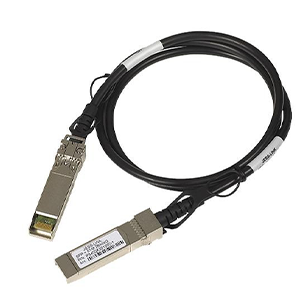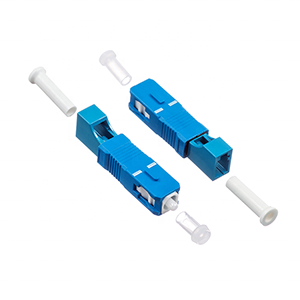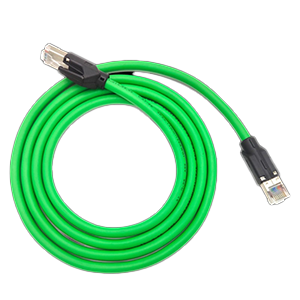As a key component widely used in high-speed networks, SFP+ optical modules play an important role in data transmission. This article will delve into the choice of passive or active cables for SFP+ optical modules. We will introduce the basic concepts of SFP+ optical modules, including their structure, working principle and application in different network equipment.
We will then compare the differences between passive and active cables, including technical characteristics, transmission rates, power consumption and cost. Next, we will explore the advantages of using passive cables and active cables and analyze their applicability in different application scenarios. Finally, we’ll cover factors to consider when choosing an SFP+ cable type to help you make an informed decision.

Basic concepts of SFP+ optical modules
Let me introduce you to the basic concepts of SFP+ optical modules:
The structure and working principle of SFP+ optical module:
- SFP+ is the abbreviation of “Small Form-factor Pluggable Plus”.
- It is a modular photoelectric converter that can be plugged into the corresponding interface of the network device.
- The SFP+ module contains a light emitter (light emitting diode), a light receiver (photodetector) and related electronic control circuits.
- The interface between optical fiber and electronic equipment is realized by converting optical signals into electrical signals, or converting electrical signals into optical signals.
- When the SFP+ module works, it interacts with the main device through electrical interfaces for data and control signals.
Usage of SFP+ in different network devices:
- Router/Switch: The SFP+ interface is used to realize optical fiber interconnection between routers and switches.
- Server/storage device: SFP+ interface is used to connect servers, storage devices, etc. to high-speed fiber optic networks.
- Wireless base station: The SFP+ interface is used for fiber optic backhaul of 5G/6G base stations to achieve high-bandwidth transmission.
- Optical transmission equipment: SFP+ interface is used for optical ports of DWDM, CWDM and other optical transmission equipment.
- Test instrument: SFP+ interface is used to test and analyze the performance of high-speed fiber optic networks.
Advantages of SFP+:
- Modular design, easy to install and maintain, and can meet different interface requirements.
- Compact size saves equipment rack space and is suitable for dense deployment.
- Supports high-speed Ethernet transmission such as 10GbE and 40GbE, with high reliability.
- It has strong compatibility and can be widely used in various network equipment and application scenarios.
In short, SFP+ optical module, as a universal optical and electrical interface, plays an important role in the current high-speed optical network. It provides a flexible and efficient solution for fiber optic interconnection between network devices.
The difference between passive cables and active cables
Let me break down the differences between passive and active cables for you:
Technical characteristics of Passive Copper Cable:
- Passive cables consist of copper wire and connectors and do not have any electronic amplification/processing circuitry.
- It completely relies on the driving capabilities of the devices at both ends and does not require external power supply.
- The transmission distance is limited, usually less than 10 meters, and is suitable for short-distance interconnections.
- The manufacturing cost is low and no additional power supply and electronic devices are required.
Technical features of Active Optical Cable (AOC):
- Active cables integrate photoelectric conversion, signal amplification and processing circuits.
- Power supply needs to be obtained from external devices to drive internal electronic circuits.
- Can achieve high-speed transmission over longer distances, generally up to more than 100 meters.
- The internal structure is more complex and the manufacturing cost is higher, but the power consumption is lower.
Performance comparison of the two cables:
- Transmission rate: Active cable supports higher transmission rates, such as 40GbE/100GbE, etc.
Passive cables generally only support rates of 10GbE and below.
- Transmission distance: Active cables can achieve longer transmission distances, usually more than 100 meters.
Passive cable transmission distance is shorter, generally no more than 10 meters.
- Power consumption: Active cables have lower power consumption because circuits are integrated inside to amplify and process signals.
Passive cables have very low power consumption because they do not have any electronic circuits.
- Cost: The manufacturing cost of passive cables is low, while the cost of active cables is relatively high due to the integrated electronic devices.
To sum up, there are obvious differences between passive cables and active cables in terms of technical implementation, performance characteristics and cost. In different application scenarios, the appropriate cable type needs to be selected based on specific transmission rate, distance and cost requirements. Active cables are suitable for high-speed, long-distance applications, while passive cables are suitable for low-speed, short-distance scenarios.
Advantages of using passive cables for SFP+ optical modules
Let me analyze for you the advantages of using passive SFP+ cables:
Simplicity and low power consumption:
- Passive SFP+ cables do not integrate any electronic circuits and have a relatively simple structure.
- No external power supply is required, reducing system complexity and power consumption.
- This simple design improves reliability and reduces maintenance costs.
Cost advantage:
- Because there are no integrated electronics, passive SFP+ cables are cheaper to manufacture.
- No power supply and control circuits are required, further reducing system costs.
- This cost advantage can lead to significant savings in large-scale deployments.
Applicable application scenarios:
- Short-distance interconnection: Passive SFP+ cables are often used for short-distance connections in computer rooms and buildings.
- Low-power devices: Passive cables are suitable for power-sensitive devices such as edge computing nodes.
- Simple network environment: Passive cables are ideal in networks that do not require long-distance transmission and complex functions.
- Temporary deployment: Passive cables are easy to install and suitable for temporary network construction or project site use.
Usage precautions:
- Limited transmission distance: The transmission distance of passive SFP+ cables usually does not exceed 10 meters and needs to be selected according to actual needs.
- No signal amplification function: Signal amplification cannot be performed on the cable, which may limit the use of certain application scenarios.
- Compatibility requirements: Full compatibility of passive cables with device ports needs to be ensured.
In short, passive SFP+ cables are very suitable for some short-distance, low-power network application scenarios due to their simplicity, low power consumption and low cost. It is a cost-effective choice when the transmission distance and functionality requirements are low.
Advantages of using active cables for SFP+ optical modules
Let me analyze for you the advantages of using active SFP+ cables:
High-speed transmission capability:
- Active SFP+ cables integrate photoelectric conversion, amplification and processing circuits.
- These electronic circuits can support higher transmission rates, such as 40GbE, 100GbE, etc.
- Active cables can achieve higher bandwidth and data throughput than passive cables.
Extended transmission distance:
- The electronic circuitry inside active SFP+ cables amplifies and clearly transmits optical signals.
- This allows active cables to support longer transmission distances, often up to 100 meters or more.
- In applications that need to span longer distances, active cables are a more suitable choice.
Compatibility and interoperability:
- Active SFP+ cables tend to use more standardized interfaces and protocols.
- This improves compatibility and interoperability with devices from different manufacturers, giving users greater choice flexibility.
- When building a heterogeneous network environment, active cables can provide better interconnection support.
Application scenarios:
- Data Center Interconnect: Active SFP+ cables play an important role in high-speed data center networks.
- 5G/6G base station backhaul: Active cables can support high-speed fiber optic backhaul between 5G/6G base stations.
- Video surveillance/conference system: Active cables can meet the bandwidth requirements for high-definition video transmission.
- Industrial automation network: Active cables are suitable for high-speed interconnection in industrial sites such as factories/warehouses.
In short, active SFP+ cables, with their excellent high-speed transmission capabilities and long-distance support, play a key role in many application scenarios that require stronger driving capabilities. Although the cost is relatively high, its performance advantages often bring greater value.
Considerations when choosing SFP+ cable type
Let me break down for you the main factors to consider when choosing an SFP+ cable type:
Bandwidth requirements and transmission distance:
- Evaluate the required transmission bandwidth, such as 10GbE, 40GbE or 100GbE, etc.
- Determine the required transmission distance, whether it is short distance (within 10 meters) or long distance (more than 100 meters).
- Choose passive or active cables based on bandwidth and distance requirements. Generally speaking, passive cables are suitable for low bandwidth and short distances, while active cables are suitable for high bandwidth and long distances.
Power consumption and cost budget:
- Evaluate the sensitivity of the device to power consumption. If there are strict limits on power consumption, passive cables are more suitable.
- Considering the overall budget cost, passive cables are usually lower cost and suitable for large-scale deployment.
- Active cables, although more expensive, can provide greater performance and compatibility.
Device Compatibility:
- Make sure the SFP+ cable you choose is fully compatible with existing network equipment (routers, switches, etc.).
- Some devices may have special requirements for specific types of SFP+ cables, which need to be confirmed in advance.
- Choose SFP+ cables recommended or certified by the equipment manufacturer to ensure full compatibility.
Other factors:
- Consider future network upgrade needs and leave appropriate performance margins.
- Evaluate the convenience of maintenance and management, such as whether hot-swappable functions are needed.
- Choose the appropriate cable type based on the characteristics of the deployment environment (machine room, factory, etc.).
In general, choosing an SFP+ cable type requires weighing factors such as bandwidth, distance, power consumption, cost, and compatibility. For different application scenarios, targeted evaluation and selection are required to achieve the best cost performance.
Summary
Through the explanation of this article, you have learned about the wide application of SFP+ optical modules in high-speed networks and the selection of passive cables and active cables. Our company provides high-quality SFP+ optical modules and related products to meet different network needs. Whether you require simplicity and low power consumption in passive cables, or high-speed transmission and long distances in active cables, we have the solution that best suits you.
We are committed to providing high-quality products and professional technical support to ensure that your network transmission is stable and reliable. When selecting an SFP+ cable type, we will provide personalized recommendations based on your specific needs and budget. Contact us today to learn more about our SFP+ optical modules and related products!
SFP+ Cable FAQ
SFP+ (Small Form-Factor Pluggable Plus) is a standard for high-speed, compact fiber optic and copper interconnect cables used in Ethernet and other networking applications.
Active SFP+ cables contain electronic components that provide signal amplification, equalization, and other signal conditioning functions. Passive SFP+ cables do not have any active electronic components.
Active SFP+ cables often have a visible bulge or module attached to the cable, indicating the presence of electronic components. Passive SFP+ cables have a more uniform, slimmer profile.
Active SFP+ cables are generally used for longer reach applications or when the signal needs to be conditioned. Passive SFP+ cables are suitable for shorter, lower-loss connections.
Active SFP+ cables can support longer transmission distances, provide better signal integrity, and are less susceptible to external interference or noise.
Passive SFP+ cables are generally less expensive, have a smaller form factor, and consume less power compared to active cables.
SFP+ ports are designed to work with both active and passive cables, but it’s important to ensure compatibility with the specific networking equipment and requirements.
Factors to consider include the required transmission distance, signal quality needs, power consumption, and the capabilities of the connected networking devices.
While it is not recommended, in some cases, active SFP+ cable modules can be removed and replaced with passive cables, or vice versa, to change the cable type.
Ongoing advancements include the development of higher-speed and more power-efficient active SFP+ cables, as well as the potential emergence of alternative interconnect standards.




